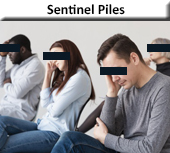Anal Cryptitis & Papilities
Cryptitis
Cryptitis is a localized infection of one of the anal glands. This unusual condition is identified anoscopically as a pearl of pus beading up from the crypt at the level of the dentate line. Treatment is obliteration of the gland, which necessarily involves an internal sphincterotomy. Fistulae and abscesses can develop with untreated prolonged infection.
Anal crypts are tiny recesses of epithelium at the upper end of the anal canal at the mucocutaneous junction. They are tiny mucus glands of lubrication arranged in a circle around the upper end of the anal canal. Located between normal structures called anal papillae, crypts are usually small, but visible enough to help give the pectinate line a serrated appearance on anoscopy.
Crypts are normal structures causing no symptoms unless they become inflamed. They are small areas of skin situated between the anal papillae. They are approximately 3 mm in depth and are lined with a single layer of epithelium, which is a continuation of the skin of the anus. Just before a bowel movement, the sphincter muscles contract and squeeze out a little drop of lubricating mucus from each of these crypts, aiding in the normal slippery passage of stool.
Cryptitis is defined as an inflammatory process in the crypts, characterized by redness, swelling, and thickening of the tissues in this area. This condition is identified proctoscopically as a pearl of pus beading up from the crypt at the level of the dentate line. Cryptic infection often causes the dissolution of the roof of the crypt, resulting in anal fissure. An infected crypt that is chronic, and fails to un-roof, can develop into an anal abscess and/or fistula.
Cryptitis is held responsible for a variety of conditions and symptoms. The pain of cryptitis is usually of the sharp lancinating or burning variety. A dull ache, or intense pain from spasm of the contraction of the sphincter muscle may develop from the inflammatory process. The nature of a crypt infection is of an ebb and flow, and may be of such a low grade that the pain is transitory.
The cause of cryptitis may be due to an inflammatory process in the adjacent areas, or a disturbance in the acid ph balance of the rectum. Trauma from constipated stools, infections introduced from external sources, parasites, foreign debris, etc., may also initiate cryptitis.
Surgical removal of a crypt is not the complete answer to treating cryptitis. The cause must be eliminated.
Enlarged Papillae
Anal papillae are prominent projections of epithelium at the upper end of the anal canal at the mucocutaneous junction. Usually they are small, but visible enough to give the pectinate line a serrated appearance on anoscopy.
Papillae are normal structures causing no symptoms unless they grow large or become inflamed. They are covered with skin-usually pale pink or whitish-and have a broad base and a fibrous tip. Enlarged papillae may elongate and Prolepse at the anal opening during defecation and may need to be replaced digitally.
Papillae may become painful, and reddened. Inflammation of papillae or crypts is frequently associated with fissures, fistulas, crohn’s disease, pruritus ani, and/or internal hemorrhoids. Inflammation of papillae may result from trauma or chemical irritation, such as the passage of hard stools or of irritating liquid stool.
Signs and symptoms of enlarged papillae may be anal discomfort, itching, burning, and sometimes pain-all intensified at bowel movement. An urgent and distressing sensation may occur (tenesmus), as if a discharge from the intestines must take place, although none can be effected.
Papillae must be differentiated from polyps, which they resemble. A biopsy may be helpful in this regard. Polyps are covered by mucosa, may bleed, and are not painful. Papillae are covered by skin, do not bleed, can be painful, and may protrude from the anus if enlarged. Polyps are often pre-cancerous, whereas papillae are not.
Although enlarged papillae can be palpated by the examiner, they are best evaluated on anoscopy. Inflammation or a pustular discharged from an adjacent crypt should be further evaluated to rule out an abscess or fistula.
Treatment should be directed to the underlying condition since most often papillae are secondary to other inflammatory anorectal lesions. Symptomatic papillae are removed by excision. If enlarged anal papillae are associated with internal hemorrhoids, they should be removed as part of the hemorrhoidectomy.




















